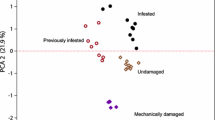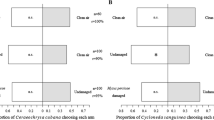Abstract
The vast majority of studies of plant indirect defense strategies have considered simple tritrophic systems that involve plant responses to attack by a single herbivore species. However, responses by predators and parasitoids to specific, herbivore-induced, volatile blends could be compromised when two or more different herbivores are feeding on the same plant. In Y-tube olfactometer studies, we investigated the responses of an aphid parasitoid, Diaeretiella rapae (McIntosh) (Hymenoptera: Braconidae), to odors from cabbage plants infested with the peach-potato aphid Myzus persicae (Sulzer) (Homoptera: Aphididae), in both the presence and absence of a lepidopteran caterpillar, Plutella xylostella L. (Lepidoptera: Plutellidae). Female parasitoids chose aphid-infested plants over uninfested plants but did not distinguish between caterpillar-infested and uninfested plants. When given a choice between odors from an aphid-infested plant and those from a plant infested with diamondback moth larvae, they significantly chose the former. Furthermore, the parasitoids responded equally to odors from a plant infested with aphids only and those from a plant infested with both aphids and caterpillars. The results support the hypothesis that the aphid and the caterpillar induce different changes in the volatile profile of cabbage plants and that D. rapae females readily distinguish between the two. Furthermore, the changes to the plant volatile profile induced by the caterpillar damage did not hinder the responses of the parasitoid to aphid-induced signals.

Similar content being viewed by others
References
Agelopoulos, N. G., and Keller, M. A. 1994a. Plant natural enemy association in the tritrophic system, Cotesia rubecula—Pieris rapae—Brassicaceae (Cruciferae). 1. Sources of infochemicals. J.Chem.Ecol. 20:1725–1734.
Agelopoulos, N. G., and Keller, M. A. 1994b. Plant natural enemy association in the tritrophic system, Cotesia rubecula—Pieris rapae—Brassicaceae (Cruciferae). 3. Collection and identification of plant and frass volatiles. J. Chem. Ecol. 20:1955–1967.
Bartlet, E., Blight, M. M., Lane, P., and Williams, I. H. 1997. The responses of the cabbage seed weevil Ceutorhynchus assimilis to volatile compounds from oilseed rape in a linear track olfactometer. Entomol. Exp. Appl. 85:257–262.
Blande, J. D., Pickett, J. A., and Poppy, G. M. 2007. A comparison of semiochemically mediated interactions involving specialist and generalist Brassica-feeding aphids and the braconid parasitoid Diaeretiella rapae. J. Chem. Ecol. 33:767–779.
Blight, M. M., and Smart, L. E. 1999. Influence of visual cues and isothiocyanate lures on capture of the pollen beetle, Meligethes aeneus in field traps. J. Chem. Ecol. 25:1501–1516.
Bradburne, R. P., and Mithen, R. 2000. Glucosinolate genetics and the attraction of the aphid parasitoid Diaeretiella rapae to Brassica. Proc. R. Soc. Lond. B 267:89–95.
Bukovinsky, T., Gols, R., Posthumus, M. A., Vet, L. E. M., and Van Lenteren, J. C. 2005. Variation in plant volatiles and attraction of the parasitoid Diadegma semiclausum (Hellen). J. Chem. Ecol. 31:461–480.
Cook, S. M., Smart, L. E., Martin, J. L., Murray, D. A., Watts, N. P., and Williams, I. H. 2006. Exploitation of host plant preferences in pest management strategies for oilseed rape (Brassica napus). Entomol. Exp. Appl. 119:221–229.
De, Boer, J. G., Snoeren, T. A. L., and Dicke, M. 2005. Predatory mites learn to discriminate between plant volatiles induced by prey and nonprey herbivores. Anim. Behav. 69:869–879.
De, Moraes, C. M., Lewis, W. J., Paré, P. W., Alborn, H. T., and Tumlinson, J. H. 1998. Herbivore-infested plants selectively attract parasitoids. Nature 393:570–573.
Dicke, M. 1999. Evolution of induced indirect defense of plants. The Ecology and Evolution of Inducible Defenses. pp. 62–88, in R. Tollrian, and C. J. Harevell (eds.). Princeton University Press, Princeton, NJ.
Dicke, M., Sabelis, M. W., Takabayashi, J., Bruin, J., and Posthumus, M. A. 1990. Plant strategies of manipulating predator-prey interactions through allelochemicals: prospects for application in pest control. J. Chem. Ecol. 16:3091–3118.
Du, Y.-J., Poppy, G. M., and Powell, W. 1996. Relative importance of semiochemicals from first and second trophic level in host foraging behavior of Aphidius ervi. J. Chem. Ecol. 22:1591–1606.
Du, Y.-J., Poppy, G. M., Powell, W., and Wadhams, L. J. 1997. Chemically mediated associative learning in the host foraging behaviour of the aphid parasitoid Aphidius ervi (hymenoptera: Braconidae). J. Insect Behav. 10:509–522.
Du, Y.-J., Poppy, G. M., Powell, W., Pickett, J. A., Wadhams, L. J., and Woodcock, C. M. 1998. Identification of semiochemicals released during aphid feeding that attract parasitoid Aphidius ervi. J. Chem. Ecol. 24:1355–1368.
Futuyma, D. J., and Gould, F. 1979. Association of plants and insects in a deciduous forest. Ecol. Monogr. 49:33–50.
Geervliet, J. B. F., Vreugdenhil, A. I., Dicke, M., and Vet, L. E. M. 1998. Learning to discriminate between infochemicals from different plant–host complexes by the parasitoids Cotesia glomerata and C. rubecula. Entomol. Exp. Appl. 86:241–252.
Girling, R. D., Hassall, M., Turner, J. G., and Poppy, G. M. 2006. Behavioural responses of the aphid parasitoid Diaeretiella rapae to volatiles from Arabipdopsis thaliana induced by Myzus persicae. Entomol. Exp. Appl 120:1–9.
Grasswitz, T. R. 1998. Effect of adult experience on the host-location behaviour of the aphid parasitoid Aphidius colemani Viereck (Hymenoptera: Aphidiidae). Biol. Control 12:177–181.
Guerrieri, E., Pennacchio, F., and Tremblay, E. 1997. Effect of adult experience on in-flight orientation to plant and plant-host complex volatiles in Aphidius ervi Haliday (Hymenoptera, Braconidae). Biol. Control 10:159–165.
Ibrahim, M. A., Nissinen, A., and Holopainen, J. K. 2005. Response of Plutella xylostella and its parasitoid Cotesia plutellae to volatile compounds. J. Chem. Ecol. 31:1969–1984.
Potting, R. P. J., Poppy, G. M., and Schuler, T. H. 1999. The role of volatiles from cruciferous plants and pre-flight experience in the foraging behaviour of the specialist parasitoid Cotesia plutellae. Entomol. Exp. Appl. 93:87–95.
Powell, W., Pennacchio, F., Poppy, G. M., and Tremblay, E. 1998. Strategies involved in the location of hosts by the parasitoid Aphidius ervi Haliday (Hymenoptera: Braconidae: Aphidiinae). Biol. Control 11:104–112.
Rodriguez-Saona, C., Crafts-Brandner, S. J., and Cañas, L. A. 2003. Volatile emissions triggered by multiple herbivore damage: beet armyworm and whitefly feeding on cotton plants. J. Chem. Ecol. 29:2539–2550.
Rostás, M., Ton, J., Mauch-Manni, B., and Turlings, T. C. J. 2006. Fungal infection reduces herbivore-induced plant volatiles of maize but does not affect naïve parasitoids. J. Chem. Ecol. 32:1897–1909.
Shiojiri, K., Takabayashi, J., Yano, S., and Takafuji, A. 2000. Flight response of parasitoids toward plant-herbivore complexes: a comparative study of two parasitoid–herbivore systems on cabbage plants. Appl. Entomol. Zool. 35:87–92.
Shiojiri, K., Takabayashi, J., Yano, S., and Takafuji, A. 2001. Infochemically mediated tritrophic interaction webs on cabbage plants. Popul. Ecol. 43:23–29.
Takabayashi, J., and Dicke, M. 1996. Plant–carnivore mutualism through herbivore-induced carnivore attractants. Trends Plant Sci. 1:109–113.
Takabayashi, J., Sabelis, M. W., Janssen, A., Shiojiri, K., and Van, Wijk, M. 2006. Can plants betray the presence of multiple herbivore species to predators and parasitoids? The role of learning in phytochemical information networks. Ecol. Res. 21:3–8.
Thompson, J. N. 1998. Coping with multiple enemies: 10 years of attack on Lomatium dissectum plants. Ecology 79:2550–2554.
Turlings, T. C. J., Tumlinson, J. H., and Lewis, W. J. 1990. Exploitation of herbivore-induced plant odors by host seeking parasitic wasps. Science 250:1251–1253.
Turlings, T. C. J., Wäckers, F. L., Vet, L. E. M., Lewis, W. J., and Tumlinson, J. H. 1993. Learning of host finding cues by hymenopterous parasitoidsInsect Learning. pp. 51–78, in D.R., Papaj, A.C., and Lewis (eds.). Chapman & Hall, London.
Turlings, T. C. J., Bernasconi, M. L., Bertossa, R., Bigler, F., Caloz, G., and Dorn, S. 1998. The induction of volatile emissions in maize by three herbivore species with different feeding habits—possible consequences for their natural enemies. Biol. Control 11:122–129.
Van Roosjen, P. R. M. P., Pumarino, L., and Dicke, M. 2003. Attraction of the specialist parasitoid Cotesia rubecula to Arabidopsis thaliana infested by host or non-host herbivore species. Entomol. Exp. Appl. 107:229–236.
Vet, and L. E. M. 1999. From chemical to population ecology: infochemical use in an evolutionary context. J. Chem. Ecol. 25:31–49.
Vet, L. E. M., and Dicke, M. 1992. Ecology of infochemical use by natural enemies in a tritrophic context. Annu. Rev. Ecol. Syst. 37:141–172.
Vos, M., Berrocal, S. M., Karamaouna, F., Hemerik, L., and Vet, L. E. M. 2001. Plant-mediated indirect effects and the persistence of parasitoid-herbivore communities. Ecol. Lett. 4:38–45.
Yan, Z. G., and Wang, C. Z. 2006. Similar attractiveness of maize volatiles induced by Helicoverpa armigera and Pseudaletia separate to the generalist parasitoid Campoletis chlorideae. Entomol. Exp. Appl. 118:87–96.
Acknowledgments
The first author is indebted to the Biotechnology and Biological Sciences Research Council (BBSRC) of the UK for financial support via the Underwood Fund and to The British Council for sponsoring the academic link with Rothamsted Research. Rothamsted Research receives grant-aided support from the BBSRC.
Author information
Authors and Affiliations
Corresponding author
Rights and permissions
About this article
Cite this article
Agbogba, B.C., Powell, W. Effect of the Presence of a Nonhost Herbivore on the Response of the Aphid Parasitoid Diaeretiella rapae to Host-infested Cabbage Plants. J Chem Ecol 33, 2229–2235 (2007). https://doi.org/10.1007/s10886-007-9379-x
Received:
Revised:
Accepted:
Published:
Issue Date:
DOI: https://doi.org/10.1007/s10886-007-9379-x




